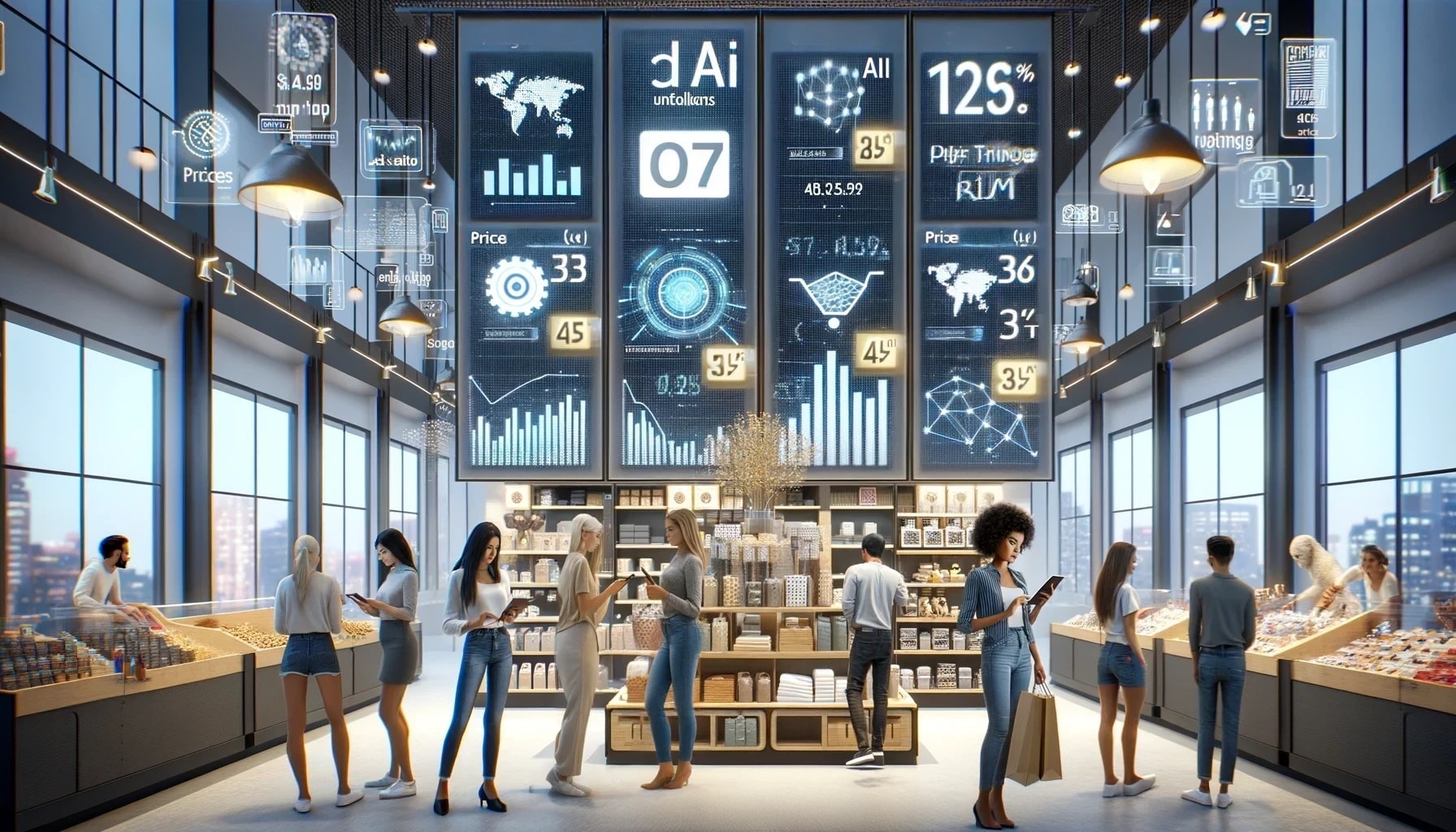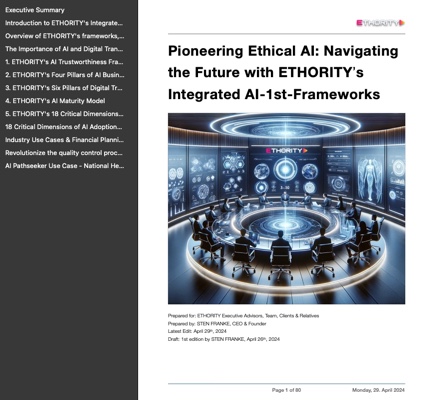Introduction to AI in Retail:
Imagine walking into your favorite store where the prices dynamically adapt based on how many people are shopping, what products are flying off the shelves, and even the weather outside. This isn’t the scene from a futuristic movie; it’s the current reality in retail, powered by Artificial Intelligence (AI). Traditional pricing strategies—often static and unresponsive—fail to meet the rapidly changing demands of today’s market. AI emerges as a transformative force, enabling retailers to fine-tune their pricing strategies with unprecedented precision and speed.
Context and Importance:
As reported by Forbes, AI excels in gathering and analyzing complex customer data, refining customer profiles, and facilitating highly targeted marketing strategies. This capability is crucial, especially considering that personalized shopping experiences are not just preferred but expected by consumers today. In fact, Epsilon highlights that 80% of consumers are more likely to make a purchase from brands that offer personalized experiences. AI doesn’t just tweak numbers; it reshapes how retailers connect with their consumers, boosting both sales and satisfaction.
Three Critical Questions We Need to Address:
- How does AI determine the right price at the right time?
- What sets AI-driven personalization apart from traditional methods?
- How do retailers integrate and manage these AI systems in real-life scenarios?
1. How does AI determine the right price at the right time?
AI leverages a combination of machine learning algorithms, predictive analytics, and real-time data to determine optimal pricing. The process begins with data collection—AI systems analyze vast datasets that include historical sales data, consumer behavior, seasonal trends, and competitive pricing. Machine learning models use this data to identify patterns and predict future buying behaviors.
Real-time data such as current market demand, inventory levels, and even external factors like weather or local events are continuously fed into these models. The AI then uses predictive analytics to forecast how these factors will influence consumer purchasing decisions. Based on these predictions, the AI dynamically adjusts the prices to match the real-time market conditions. This ensures that the pricing is not only competitive but also maximizes profitability and minimizes stock-outs.
2. What sets AI-driven personalization apart from traditional methods?
AI-driven personalization differs significantly from traditional methods in its ability to process and analyze data at scale and speed. Traditional personalization techniques often rely on static segmentation models that group customers based on broad criteria such as age, location, or past purchases. However, these methods lack the capability to adapt to real-time changes in consumer behavior and preferences.
In contrast, AI-driven personalization utilizes advanced algorithms that can dig deeper into individual customer data, learning from each interaction to create highly accurate and dynamic consumer profiles. AI systems can recommend products, adjust marketing messages, and even tailor pricing in real-time based on a comprehensive understanding of each customer’s unique preferences, buying habits, and potential value to the retailer. This level of personalization enhances the customer experience significantly, leading to higher engagement, satisfaction, and loyalty.
3. How do retailers integrate and manage these AI systems in real-life scenarios?
Integrating and managing AI systems in retail environments involves several steps, starting with the selection of the right technology that aligns with the business’s specific needs. Retailers often work with AI technology providers to implement solutions that are customized to their operational frameworks and customer demographics.
Once an AI system is chosen, retailers typically undergo a phase of pilot testing, where the system is implemented in a controlled environment to test its effectiveness and make necessary adjustments. During this phase, data scientists and AI specialists monitor the system’s performance closely, ensuring it integrates seamlessly with existing IT infrastructure, like CRM and ERP systems.
Post-implementation, ongoing management of AI systems involves regular updates and training sessions for staff to ensure they understand how to use the technology effectively. Retailers also need to continuously feed data back into the AI to help it learn and improve. This iterative process allows the AI system to evolve with the business and market conditions, ensuring it remains effective over time.
Overall, integrating AI into retail settings is a transformative move that requires careful planning, execution, and management, but the results—increased efficiency, improved customer experiences, and higher profitability—can significantly outweigh the challenges.
Mechanisms of AI in Retail
Machine Learning Algorithms: AI systems in retail predominantly utilize machine learning (ML) algorithms to process and analyze data. These algorithms range from supervised learning, which requires historical data with known outcomes to train models, to unsupervised learning, which finds hidden patterns and relationships in data without needing predefined labels. For pricing, reinforcement learning can also be significant, where the system learns optimal actions through trial and error to maximize a specific performance criterion related to sales and customer satisfaction.
Data Sources and Integration: The effectiveness of AI in retail depends on the diversity and quality of data it processes. This data includes:
- Historical sales data: Trends, seasonality, and sales performance.
- Competitor pricing: Regular monitoring of competitors’ pricing strategies.
- Consumer behavior data: Purchasing patterns, browsing history, and product preferences.
- External factors: Economic indicators, weather conditions, and local events.
AI systems integrate this data from various sources, often using data lakes where vast amounts of structured and unstructured data are stored and made accessible for analysis.
Big Data Analytics: Big data analytics plays a crucial role in handling the volume, velocity, and variety of data collected. Tools and technologies like Hadoop, Spark, and real-time analytics platforms enable the processing of large datasets efficiently. These technologies help in cleansing, aggregating, and transforming data into a usable format for machine learning models.
Predictive Analytics and Forecasting: Using statistical techniques and machine learning models, AI predicts future consumer behaviors and market trends. Predictive models might use regression analysis, neural networks, or ensemble methods to forecast demand and optimize pricing strategies accordingly. The AI’s ability to forecast is based on continuously updated data, allowing it to adapt to new trends as they emerge.
Continuous Learning and Adaptation: One of the most significant advantages of AI systems is their ability to learn and adapt over time. As new data comes in, the models are retrained or fine-tuned to improve their accuracy. This continuous learning process is supported by feedback loops where the outcomes of AI-driven decisions (e.g., changes in pricing or personalized marketing actions) are analyzed to further refine the models.
Automation and Decision Making: Finally, AI enables the automation of decision-making processes, allowing for real-time responses to changing market conditions. By setting predefined rules and parameters, AI systems can make autonomous pricing decisions within milliseconds, reacting faster than any human could to adjust prices in response to immediate market changes or inventory levels.
By leveraging these technical mechanisms, AI provides a powerful tool for retailers to optimize their pricing strategies and personalize customer interactions, ensuring they remain competitive and responsive to the dynamic retail environment.
Case Study: Major Fashion Retailer Implements AI for Dynamic Holiday Pricing
Background: A prominent fashion retailer, facing intense competition and significant pressure to maximize holiday sales, turned to AI to overhaul its pricing strategy. The goal was to adapt more swiftly to market demands and consumer behavior changes, particularly during the high-stakes holiday shopping season.
Implementation: The retailer integrated an AI system designed to analyze multiple data streams, including:
- Real-time store traffic: Sensors and analytics tools tracked customer movements and density within stores.
- Online shopping trends: E-commerce platforms provided data on page views, cart additions, and purchase rates.
- Inventory levels: Real-time updates on stock status helped adjust prices to manage supply effectively.
- Competitive pricing: AI tools continuously scanned competitor pricing to ensure competitive positioning.
AI Strategy: The AI system employed machine learning models to process this data, identifying patterns that signaled when and how prices should be adjusted. The models were trained to forecast demand surges, detect dwindling interest in specific items, and suggest optimal price points that balanced sales volume with profit margins.
Execution: Throughout the holiday season, the AI system dynamically adjusted prices on key product lines. When store traffic peaked, prices were optimized to convert high interest into sales without sacrificing margins. During slower periods, the system recommended promotions to attract more buyers and clear out overstock. Online, prices were adjusted in real-time to respond to web traffic and abandonment rates at checkout.
Results: The implementation of AI-driven dynamic pricing led to:
- 25% Increase in Sales: Compared to the previous year, the retailer saw a substantial rise in sales figures, attributed directly to more strategic pricing and promotions.
- Improved Inventory Management: The AI’s predictions helped reduce overstock by aligning inventory levels with actual consumer demand, minimizing end-of-season markdowns.
- Enhanced Customer Satisfaction: Shoppers perceived the pricing as fair and responsive, which improved overall customer satisfaction and loyalty. Feedback indicated that customers appreciated deals that seemed tailored to their interests and timing.
Analysis: Post-season analysis revealed that AI not only facilitated effective pricing adjustments but also provided deep insights into customer behavior and preferences. These insights allowed the retailer to refine its marketing and operational strategies further.
Future Implications: Encouraged by these results, the retailer plans to expand the use of AI into other areas such as personalized marketing campaigns and enhanced customer service, anticipating even greater efficiency and customer engagement.
This case study showcases how AI can revolutionize retail operations by enabling real-time, data-driven decision making that aligns closely with market dynamics and consumer preferences. By leveraging AI for dynamic pricing, retailers can not only boost their profitability during critical periods but also enhance their customer relationships through more personalized and responsive service.
Ways of Evaluating & Analyzing Results
1. Defining Key Performance Indicators (KPIs):
To accurately assess the impact of AI on retail pricing, retailers must first establish clear and relevant KPIs. Commonly used metrics include:
- Conversion Rates: Measures the percentage of transactions relative to the total number of visits or interactions, indicating the effectiveness of AI-driven pricing in turning prospects into customers.
- Customer Retention Rates: Tracks how well the retailer keeps its customer base over a given period, reflecting the success of personalized pricing and promotions in fostering customer loyalty.
- Return on Investment (ROI): Evaluates the financial return on AI investments by comparing the net profit to the cost of the AI systems. This KPI is vital for understanding the profitability and viability of the technology.
2. Implementing Control Tests and Pilot Programs:
To objectively measure the impact of AI, retailers should conduct controlled experiments:
- A/B Testing: In this approach, two versions of pricing strategies (one AI-driven and one not) are implemented simultaneously to compare their performance directly. This method can help isolate the effect of AI from other variables.
- Pilot Programs: Before a full rollout, AI-driven pricing can be tested in selected stores or specific product lines. This phased approach helps identify potential issues and ensures that the system aligns with business objectives without disrupting overall operations.
3. Data Collection and Analysis:
Continuous data collection is essential for evaluating AI systems. Retailers need to integrate their data analytics platforms with AI systems to capture and analyze performance data continuously. This integration allows for real-time monitoring and assessment, providing insights into how well the AI adapts to and predicts market changes.
4. Feedback Loops:
Creating feedback mechanisms where sales data and customer feedback directly influence AI algorithms is crucial. These feedback loops help AI systems to learn and evolve, improving their accuracy and effectiveness over time. Regular reviews of these feedback loops can also provide insights into areas where AI may require adjustments or additional training.
5. Comparative Analysis:
Finally, comparing pre-and post-AI implementation metrics provides a clear picture of the system’s impact. Retailers should look at historical performance data to benchmark AI’s improvements and identify trends or shifts in consumer behavior attributable to AI-driven pricing strategies.
6. Stakeholder Reviews and Reporting:
Regular reporting to stakeholders, including detailed analysis and insights from AI performance metrics, ensures transparency and supports strategic decision-making. These reviews can help refine goals, adjust strategies, and allocate resources more effectively based on AI’s performance.
By systematically measuring and analyzing these aspects, retailers can effectively evaluate the success of AI in retail pricing. This evaluation not only justifies the investment in AI technologies but also guides future enhancements to ensure that the AI continues to meet the evolving demands of the retail market.
80% of consumers are more likely to make a purchase from brands that offer personalized experiences
Conclusion
The retail sector is undergoing an unprecedented transformation, driven by the rapid evolution of technology and changing consumer expectations. Artificial Intelligence (AI) stands at the heart of this revolution, providing tools that can decipher complex consumer data, predict market trends, and dynamically adjust pricing strategies in real-time. The businesses that harness these capabilities are not merely reacting to changes; they are proactively shaping their futures, ensuring relevance and competitiveness in a crowded market.
AI’s capability to personalize consumer experiences — tailoring product recommendations and pricing to individual preferences and behaviors — has shifted from a competitive advantage to a fundamental operational necessity. With studies showing that 80% of consumers are more likely to make a purchase from brands that offer personalized experiences, the message is clear: integrating AI into retail operations is no longer optional but essential for survival and growth.
Furthermore, the real-time analytics provided by AI allows for an agile approach to pricing and inventory management, reducing waste and increasing profitability. Retailers equipped with AI technologies can adapt swiftly to both expected and unforeseen changes in the market, from shifting consumer trends to supply chain disruptions.
Take Action
For decision-makers in retail, the path forward must involve a strategic embrace of AI technologies. It is crucial to begin by identifying areas within your operations where AI can have the most immediate impact, such as pricing strategies and customer personalization. Investing in the right AI technology requires selecting partners and solutions that align with your specific business needs and customer demographics.
The next step is to pilot AI systems within your operations, measure their effectiveness meticulously, and scale these solutions based on proven results. The journey of integrating AI into your business is iterative and requires continuous learning and adaptation.
Retail leaders must also foster a culture that embraces digital transformation, where innovation is encouraged, and new technologies are rapidly assimilated. Providing training and continuous learning opportunities for your team will ensure that your organization not only implements AI but excels at using it to its full potential.
In conclusion, as the retail landscape continues to evolve, the integration of AI into retail strategies is not just about keeping up. It’s about staying ahead, anticipating market trends, and meeting consumer demands with unprecedented precision and personalization. The time to act is now — embrace AI, and redefine the future of retail.
Harness the power of AI, and transform the way you meet the demands of your consumers. The future of retail is not just responding to changes—it’s predicting them and acting with confidence. Let AI be your guide in this journey.



